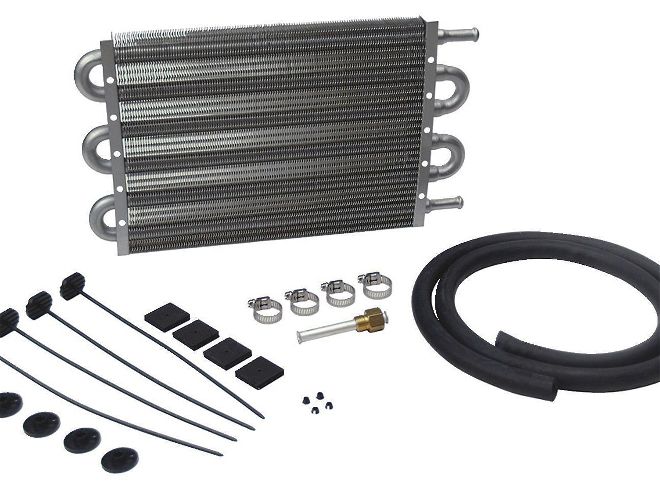
Engine oil, transmission fluid and gear lube are the lifeblood of your classic pickup (or any piece of motorized equipment for that matter), and making sure these fluids are kept in optimal condition is really important for their (our vehicle’s) long-term health. Now, I’d venture a guess that many of us pay closer attention to our classic truck’s maintenance than we do our everyday drivers, but I’m sure there’s room for improvement in nearly all cases (I know my maintenance regimen could use some help).
Above and beyond regular fluid and filter changes, oil and fluid temperature control is an extremely important subject that we should perhaps pay a bit more attention to. I think it’d be safe to say that the vast majority of our classic trucks and hot rods are equipped with trans coolers (at least those equipped with automatics anyway), but are they really doing the job? In other words, did we just get to that point in a build and grab any old cooler assembly and stick it wherever we could fit it – and then forgot about it? I thought so, and to be honest, I’m also guilty as charged.
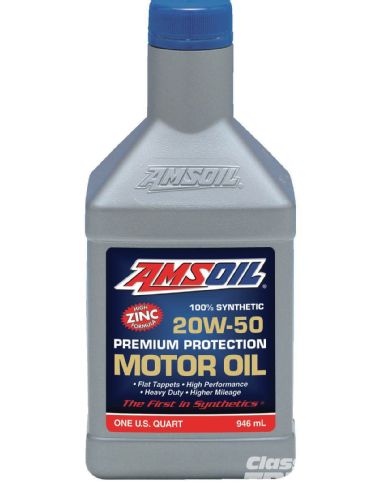 Transmission and engine oil coolers are an important part of any vehicle. Whether it’s your own body or your pickup’s engine, carrying extra weight takes extra energy, and extra energy creates additional heat. The danger in situations like these is overwork and overheating. Excessive heat breaks down lubricants, which in turn will damage your engine, and we all know that often leads to expensive repairs, or even worse, breakdowns. The same work/heat relationship holds true for your truck’s transmission, as well. The Summit engine oil cooler pictured here is a perfect example of an affordable and easy-to-install kit that takes oil from the pan, runs it through a special “sandwich” oil filter adapter, passes it through four 5⁄8-inch aluminum cooling tubes, then returns it to the adapter. From there, the cooled oil goes into the engine’s oil galleries. The coolers come with the sandwich filter adapter (for use with a Fram PH8A or equivalent filter), universal adapter bushings, ½-inch high-temperature/high-pressure hose, brass fittings, stainless steel hose clamps, mounting hardware and instructions.
Transmission and engine oil coolers are an important part of any vehicle. Whether it’s your own body or your pickup’s engine, carrying extra weight takes extra energy, and extra energy creates additional heat. The danger in situations like these is overwork and overheating. Excessive heat breaks down lubricants, which in turn will damage your engine, and we all know that often leads to expensive repairs, or even worse, breakdowns. The same work/heat relationship holds true for your truck’s transmission, as well. The Summit engine oil cooler pictured here is a perfect example of an affordable and easy-to-install kit that takes oil from the pan, runs it through a special “sandwich” oil filter adapter, passes it through four 5⁄8-inch aluminum cooling tubes, then returns it to the adapter. From there, the cooled oil goes into the engine’s oil galleries. The coolers come with the sandwich filter adapter (for use with a Fram PH8A or equivalent filter), universal adapter bushings, ½-inch high-temperature/high-pressure hose, brass fittings, stainless steel hose clamps, mounting hardware and instructions.
How about engine oil coolers? You know they’re not just for race or tow vehicles. Those fairgrounds cruisers that putt for hours at an event end up runnin’ at pretty high engine temps, don’t they? Ya think an oil cooler might be in order in those cases, too? I think so. Now that you have my two cents let’s take a look at some fluid and cooler info that may help increase the life and mechanical health of our pickups. Though the crux of this is oil and trans coolers I found some good background info on oil that I found interesting and thought you might find interesting, as well. So, let’s start out by taking a look at the fluids we’re trying to keep cool.
Oil Classifications
If you’ve ever paid attention to the small print on a quart of oil I’m sure you’ve noticed some classifications listed there – SAE and API. The SAE (Society of Automotive Engineers) and the API (American Petroleum Institute) classifications actually designate the type of engines for which the oil was designed. More often than not, SAE viscosity grades incorporate “W” numbers when classifying multi-grade oils like 10W30 or 20W50, for example.
 Synthetic lubricants are my personal choice and I use ’em in my classic trucks and everyday drivers. In fact, the 20W50 AMSOIL pictured here is exactly what I use in the full-size Dodge pickup I tow my travel trailer with (Candy and I run AMSOIL 10W40 in our hot rods). And we do run coolers (both oil and tranny) in all our vehicles, too.
Synthetic lubricants are my personal choice and I use ’em in my classic trucks and everyday drivers. In fact, the 20W50 AMSOIL pictured here is exactly what I use in the full-size Dodge pickup I tow my travel trailer with (Candy and I run AMSOIL 10W40 in our hot rods). And we do run coolers (both oil and tranny) in all our vehicles, too.
From what I gather, the lower the first number, the better the oil will perform in extremely cold conditions. Conversely, the higher the second number, the better the oil will protect at higher temps. If you live in a cold weather state like Minnesota or North Dakota, during the winter months you’d want a lowest number like a 5W30. In a warm climate like southern California or Arizona, a 10W40 or a 20W50 would be a better choice. The API typically uses an “S” designation for gasoline engines and a “C” designation for diesel engines. The majority of today’s oils carry an SH, CF or SJ – CF designation signifying that they are suitable for use in all gasoline or diesel applications.
Petroleum and Synthetic Lubricants
During the course of my investigation into lubricants, I found out that synthetic oils were originally developed more than 50 years ago primarily for aircraft engines. I originally thought that it was a much newer technology. Extremely cold (-120 degrees at altitude) temperatures, high rpm’s (upwards of 60,000), and extremely hot (500 degrees plus) exhaust temps were just way too much for conventional oils, breaking them down in short order.
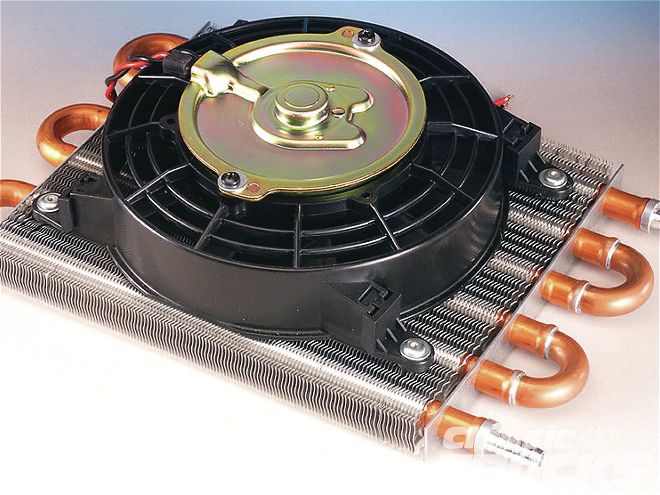 In situations where locations are few and far between, like the close confines of a street rod, coolers with integral cooling fans are the answer. This Flex-a-lite model #4190 is a perfect example. It’s tube-and-fin design that measures 7½x12x31⁄8-inches and is rated for 16,000 lbs GVW. Designs such as this provide cooling where free airflow isn’t available.
In situations where locations are few and far between, like the close confines of a street rod, coolers with integral cooling fans are the answer. This Flex-a-lite model #4190 is a perfect example. It’s tube-and-fin design that measures 7½x12x31⁄8-inches and is rated for 16,000 lbs GVW. Designs such as this provide cooling where free airflow isn’t available.
Synthetics were developed with petroleum-based lubes’ shortcomings in mind and were specifically formulated to withstand harsh aviation engine demands. To this day, synthetic lubricants are the standard in the aircraft industry because of their ability to perform in such harsh environments. Since AMSOIL (my personal choice of lubricants) introduced the first synthetic oil for automotive use back in ’72, synthetic lubricants have become increasingly popular because of their excellent lubricating properties, greater ability to flow at cold temperatures, and their ability to withstand high temperatures for extended periods of time. In fact, more and more new cars are being delivered with synthetic oil in the crankcase – and also require synthetic oil use throughout their service lives.
From what I understand, the two primary differences between synthetic and conventional petroleum oils are the base stock (the liquid that makes up the volume of the oil), and the additive package. There are additives (not to be confused with over-the-counter parts store stuff) in all oils that enhance the wear-resistance properties, the ability of the oil to neutralize acids and combustion by-products and provide corrosion protection for the engine’s internal surfaces. The amount and quality of these additives vary from one brand to another and are critical factors in the ability of any oil to adequately protect an engine in varying driving conditions. As a rule of thumb though, you’d figure the cheaper the oil, the fewer additives it has and therefore, the less able it is to protect your engine.
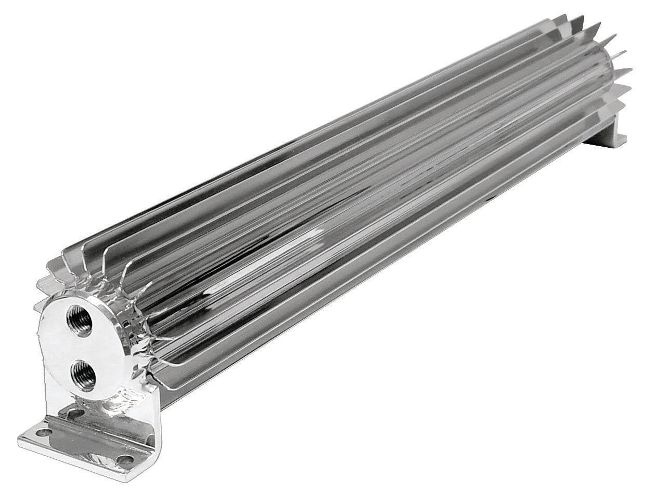 Dual-pass coolers are a great option for street rodders and have all the benefits plus the good looks us truckers prefer. This good-looking unit is a nice example; it’s a finned aluminum dual-pass Specialty Auto cooler offered by Cool Craft. The neat thing about coolers such as these (above and beyond their great looks) is they really are sturdily constructed and will stand up to punishment like flying road debris – plus they’re designed to work with any type of fluid like ATF, engine oil, coolant or power steering fluid. The heat-sink design and both internal and external cooling fins transfer heat even in situations where there’s restricted airflow. These babies are available in six sizes, from 12 inches long to 24 inches.
Dual-pass coolers are a great option for street rodders and have all the benefits plus the good looks us truckers prefer. This good-looking unit is a nice example; it’s a finned aluminum dual-pass Specialty Auto cooler offered by Cool Craft. The neat thing about coolers such as these (above and beyond their great looks) is they really are sturdily constructed and will stand up to punishment like flying road debris – plus they’re designed to work with any type of fluid like ATF, engine oil, coolant or power steering fluid. The heat-sink design and both internal and external cooling fins transfer heat even in situations where there’s restricted airflow. These babies are available in six sizes, from 12 inches long to 24 inches.
One reason synthetics are deemed superior is that they almost always have more and higher-quality additives than standard petroleum-based products. Another is that the synthetic (versus petroleum-based) formulations enable them to last many times longer than conventional oil before they begin to degenerate. The synthetic base stock, however, is at the heart a synthetic oil’s ability to flow at cold temperatures and withstand greater amounts of heat over significantly longer periods of time.
Petroleum base stocks are sensitive to stress and heat. Additionally, various waxes that are contained in all petroleum products, regardless of how well refined they are, cause oil to thicken or jell at extremely cold temperatures. At the other end of the temperature spectrum, high-engine temperatures and heavy loads (as typically found in towing or high-performance applications) cause these lubricants to break down and the conventional base stock of petroleum actually boils off – causing viscosity breakdown and sludge formation. And check this out – this can happen at temperatures as low as 230 degrees, and in fact, by 250 degrees many petroleum oils will already be suffering significant breakdown.
Synthetic oils, on the other hand, are engineered specifically to provide all the lubricating properties that natural oil possesses, but none of the cold thickening or hot thinning properties of petroleum oil. Synthetics are formulated so that they can withstand prolonged temperatures of 300 degrees and still protect your engine. In fact, the American Society of Testing Materials (ASTM) standard wear-resistance tests are conducted at 302 degrees, and in those tests synthetic lubes outperform petroleum lubricants by a factor of 4:1 and sometimes more. The point being, synthetic oils have a much wider operating temperature range by design than petroleum oils, but performance engines will benefit from an engine oil cooler, so don’t think cuz you run synthetic oil that you can take a pass. This said, an engine oil cooler is an accessory that we should seriously consider, especially since its cheap insurance relative to our overall street rod investments.
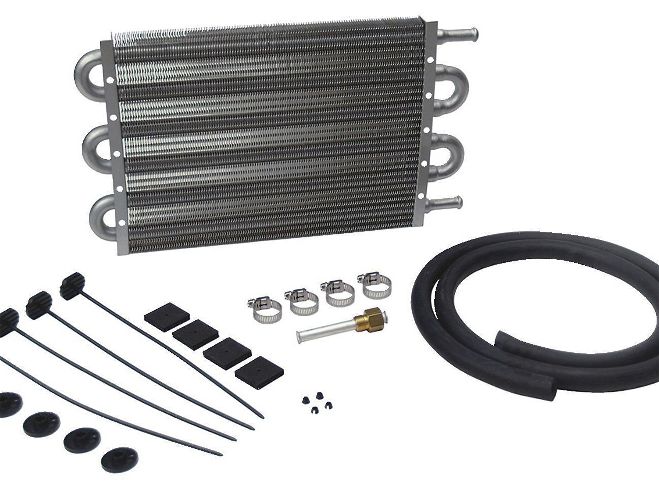 This Summit Racing Equipment offering (part #SUM-G4960A) is a good representation of an affordable cooler setup that’ll help your transmission’s fluid stay between 160 and 200 degrees, so it’ll live a long life. Coolers like these are available in a variety of dimensions, in both ¾-inch-thick styles, and heavy-duty 1½-inch thick versions. Either way, they feature the tried and true aluminum tube-and-fin design and are sold with high-temperature/high-pressure hoses, mounting hardware and instructions.
This Summit Racing Equipment offering (part #SUM-G4960A) is a good representation of an affordable cooler setup that’ll help your transmission’s fluid stay between 160 and 200 degrees, so it’ll live a long life. Coolers like these are available in a variety of dimensions, in both ¾-inch-thick styles, and heavy-duty 1½-inch thick versions. Either way, they feature the tried and true aluminum tube-and-fin design and are sold with high-temperature/high-pressure hoses, mounting hardware and instructions.
A Few Words on Transmissions
If you think your street rod’s engine works hard, think about what your tranny goes through. Your transmission basically keeps your engine’s rpm’s within a usable range and transmits that horsepower from the crank to the drive wheels no matter how hard you stomp on the gas. This process generates a ton of heat, and in order to keep the heat relatively low, transmissions rely on transmission fluid to lubricate and cool the moving parts.
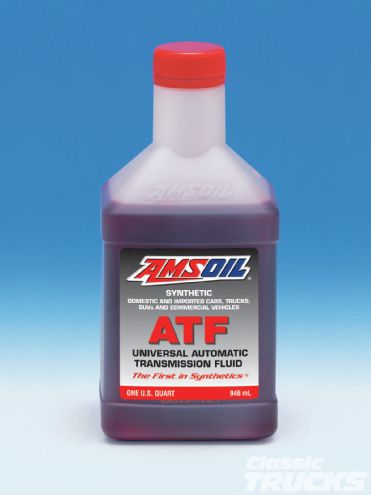 As good as top-quality synthetic lubes are, sometimes the transmission fluid just isn’t enough to keep everything cool. There are times when the fluid temperature can exceed the maximum range of 160 to 200 degrees, and when this happens the fluid begins to burn. This decreases the amount of fluid running through your transmission, which in turn can seriously damage all of the important moving parts within the transmission. Installing a transmission cooler is an extra precaution against overheating your transmission, and many people decide to use them in not only tow vehicles, but classic trucks and hot rods. As you can see, transmission coolers come in many different shapes and sizes, and there are things to consider when choosing one.
As good as top-quality synthetic lubes are, sometimes the transmission fluid just isn’t enough to keep everything cool. There are times when the fluid temperature can exceed the maximum range of 160 to 200 degrees, and when this happens the fluid begins to burn. This decreases the amount of fluid running through your transmission, which in turn can seriously damage all of the important moving parts within the transmission. Installing a transmission cooler is an extra precaution against overheating your transmission, and many people decide to use them in not only tow vehicles, but classic trucks and hot rods. As you can see, transmission coolers come in many different shapes and sizes, and there are things to consider when choosing one.
Sometimes the transmission fluid just isn’t enough to keep everything cool. There are times when the fluid temperature can exceed the recommended range of 170 to 200 degrees, and when this happens, the fluid begins to burn. This decreases the amount of fluid running through your transmission, which in turn can seriously damage parts within the transmission, often leaving ya stranded in the least desirable location.
Installing a transmission cooler is an extra precaution against overheating your transmission, and many people decide to use them not only in tow vehicles, but performance vehicles, as well. Transmission coolers come in many different shapes and sizes, and there are a few things to consider when choosing one.
Perhaps the most important factor to consider is the vehicle itself. How much does it weigh, and are ya going to load it up with cargo relatively often? Matching a tranny cooler to your vehicle’s gross weight is critical to allow this add-on cooler to operate properly. (You can get specifics from the pros by contacting any of the engine/trans cooler advertisers you see here in CT.)
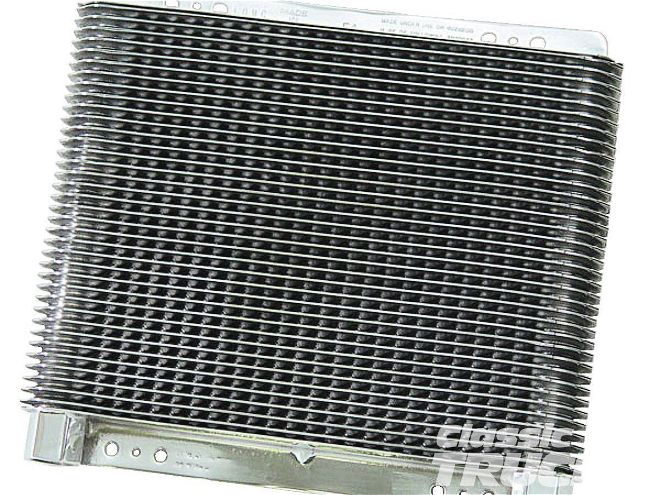 Another popular cooler style is the stacked-plate design like the B&M Super Cooler shown here. These coolers use pairs of aluminum plates to define oil flow. The plates and fins provide multiple cooling paths that gives ’em the cooling capacity of larger fin-and-tube coolers. And, because they have a low pressure-drop design, there is less oil system restriction.
Another popular cooler style is the stacked-plate design like the B&M Super Cooler shown here. These coolers use pairs of aluminum plates to define oil flow. The plates and fins provide multiple cooling paths that gives ’em the cooling capacity of larger fin-and-tube coolers. And, because they have a low pressure-drop design, there is less oil system restriction.
As is the case with engine oil, AMSOIL synthetic ATF (again I mention it cuz it’s the brand I use), exceeds the performance requirements for domestic transmission fluid applications and provides automatic transmissions and power-steering units with excellent lubricating protection and better performance over a wider temperature range than conventional automatic transmission fluids. Being a synthetic, it resists thermal and oxidative degradation better than conventional transmission fluids, protecting your tranny and its internals from damaging sludge and varnish deposits. More importantly, it helps prevent component overheating and ensures cooler, smoother transmission operation.
Too low a transmission fluid temperature is not a good thing either (a fact that I was not aware of until I started to do some reading up on the subject), and again, synthetics outperform petroleum fluids in low temperature fluidity.
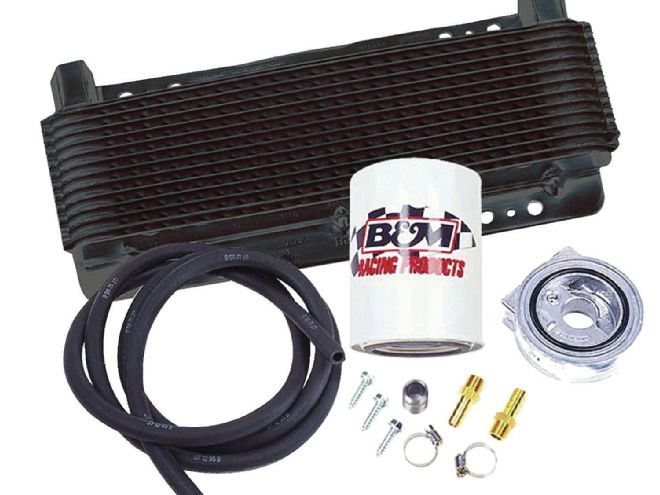 While we’re on the subject of stacked-plate coolers, B&M offers kits that include trans fluid filter and cooler combos, too. These are great for larger fat-fendered street rods or classic trucks that weigh a lot more than smaller, lighter vehicles.
While we’re on the subject of stacked-plate coolers, B&M offers kits that include trans fluid filter and cooler combos, too. These are great for larger fat-fendered street rods or classic trucks that weigh a lot more than smaller, lighter vehicles.
That said, I think there’s a good argument for getting a better education with regards to engine oil and transmission fluid coolers. The pages of CT are chock full of engine, transmission and cooler manufacturers and dealers that, unlike myself, are experts and I urge you to take the time to hit up their many websites or check in with their tech lines to bone up on the subject. Our classic pickups are large investments in both cash and effort, and anything that can be done to ensure they stay up and runnin’ is worth the time and effort needed to keep ’em that way. Stay cool, and have fun! CT
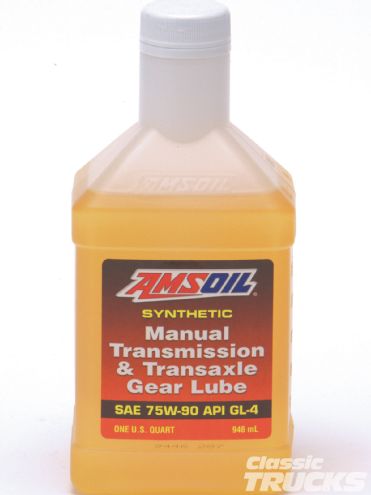 When talking about lubricants and coolers, we shouldn’t forget to mention components like manual transmissions and differentials either. Though aside from severe off-road applications, these components are rarely outfitted with external cooling mechanisms – that’s a great argument for using the absolute best lubricants like the synthetic gear lube shown here. Remember, you’ve got a big investment in both cash and labor invested in your pickup and paying attention to lubes and cooling is more than worthwhile.
When talking about lubricants and coolers, we shouldn’t forget to mention components like manual transmissions and differentials either. Though aside from severe off-road applications, these components are rarely outfitted with external cooling mechanisms – that’s a great argument for using the absolute best lubricants like the synthetic gear lube shown here. Remember, you’ve got a big investment in both cash and labor invested in your pickup and paying attention to lubes and cooling is more than worthwhile.
Many people with questions about synthetics haven’t known where to turn for correct information. Is it super oil or snake oil? Some enthusiasts will swear that synthetics are capable of raising your specialty car from the dead. On the other hand, the next fellow asserts that synthetics will send your beloved car to an early grave. Where’s the truth in all this?
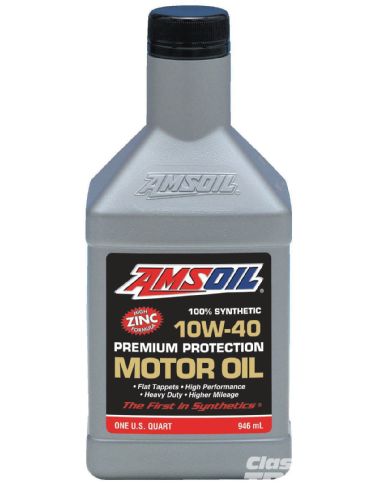
In an effort to set the record straight, here we’ve assembled 10 of the more persistent myths about synthetic motor oils to see how they stack up against the facts.
Synthetic motor oils damage seals.
Untrue.
It would be foolhardy for lubricant manufacturers to build a product that is incompatible with seals. The composition of seals presents problems that both petroleum oils and synthetics must overcome. Made from elastomers, seals are inherently difficult to standardize. Ultimately it is the additive mix in oil that counts. Additives to control seal swell, shrinkage and hardening are required, be it a synthetic or petroleum product.
Synthetics cause engines to use more oil.
Untrue.
Synthetic motor oils are intended for use in mechanically sound engines, that is, engines that don’t leak. In such engines, oil consumption will actually be reduced. First, because of the lower volatility of synlubes; second, because of the better sealing characteristics between piston rings and cylinder walls, and finally, because of the superior oxidation stability (i.e. resistance of synthetics against reacting with oxygen at high temperatures).
Synthetic lubricants are not compatible with petroleum.
Untrue.
The synthesized hydrocarbons, polyalphaolefins, diesters and other materials that form the base stocks of high-quality name-brand synthetics are fully compatible with petroleum oils. In the old days, some companies used untested ingredients that were not compatible, causing quality synlubes to suffer a bum rap. Fortunately, those days are long gone. Compatibility is something to keep in mind, however. Whether using petroleum oils or synthetics, it is usually best to use the same oil for topping off that you have been running in the engine. That is, it is preferable not to mix your oils, even if it is Valvoline or Quaker State you are using. The reason is this: the functions of additives blended for specific characteristics can be offset when oils with different additive packages are put together. For optimal performance, it is better to use the same oil throughout.
Synthetics can’t be used with catalytic converters or oxygen sensors.
Untrue.
There is no difference between synthetic and petroleum oils in regard to these components. Both synthetic and petroleum motor oils are similar compounds and neither is damaging to catalytic converters or oxygen sensors.
Synthetics void warranties.
Untrue.
No major manufacturer of automobiles specifically bans the use of synthetic lubricants. In fact, increasing numbers of high-performance cars are arriving on showroom floors with synthetic motor oils as factory fill. New vehicle warranties are based upon the use of oils meeting specific API Service Classifications (for example, SG/CE). Synthetic lubricants which meet current API Service requirements are perfectly suited for use in any vehicle without affecting a new car warranty. In the 25 years that AMSOIL Synthetic Lubricants have been used in extended service situations, and over billions of miles of actual driving, these oils have not been faulted once for voiding an automaker’s warranty.
Synthetics last forever.
Untrue.
Although some experts feel that synthetic base stocks can be used forever, it is well known that eventually the additives will falter and cause the oil to require changing. Moisture, fuel dilution and acids (the by-products of combustion) tend to use up additives in oil, allowing degradation to occur. However, by “topping off,” additives can be replenished. Through good filtration and periodic oil analysis, synthetic engine oils protect an engine for lengths of time far beyond the capability of non-synthetics.
Conclusion
Since their inception, manufacturers of synthetic motor oils have sought to educate the public about the facts regarding synthetics, and the need for consumers to make their lubrication purchasing decisions based on quality rather than price. As was the case with microwave ovens or electric lights, a highly technological improvement must often overcome a fair amount of public skepticism and consumer inertia before it is embraced by the general public.